Market Size of India Direct-to-Consumer (D2C) Logistics Industry

| Study Period | 2020 - 2029 |
| Base Year For Estimation | 2023 |
| Forecast Data Period | 2024 - 2029 |
| Historical Data Period | 2020 - 2022 |
| CAGR | > 8.00 % |
| Market Concentration | Low |
Major Players.webp)
*Disclaimer: Major Players sorted in no particular order |
Need a report that reflects how COVID-19 has impacted this market and its growth?
India Direct-to-Consumer Logistics Market Analysis
The Indian Direct-to-Consumer logistics market is estimated to register a CAGR of more than 8% during the forecast period.
- Over the past few years, the D2C model gained traction in India due to the growth in e-commerce penetration, the rise in digital infrastructure, the growing millennial population, an increase in consumer tech awareness, and a growing number of D2C startups and their diverse offerings. However, the much-required push due to the Covid-19 outbreak helped the D2C sector reach a tipping point. A series of lockdowns to contain the pandemic, people's fear of going out (FOGO), and the social distancing mandate brought about a paradigm shift in consumers' mindset, urging them to opt for digital platforms. As a result, the D2C market is expected to grow exponentially in the forecast period.
- The D2C model is becoming increasingly popular in India. Companies such as Sugar and Mamaearth benefited greatly from the digital D2C model, resulting in exponential development. Established FMCG brands such as Himalaya, ITC, and Hindustan Unilever are experiencing severe competition from upstart D2C businesses such as Mamaearth, Pee Safe, Moms Co., and others. Many companies are turning to this model because the D2C e-commerce model literally "cuts out" the middleman.
- Before the pandemic began, only a few direct-to-consumer companies raised money, approximately 2-3 companies per week on average. With COVID-19 spreading, companies started investing in the D2C models. Around 146 companies raised USD 500 million in the first half of 2020. With the change in consumer behavior due to COVID-19, more customers turned online to purchase the products. The need to meet rising demand becomes more important. But most D2C sellers may need more resources to manage end-to-end operations independently. It is when they turn to third-party logistics and fulfillment companies for effective order administration, streamlined operations, and flawless shipment last-mile delivery. It is where efficient logistics companies and last-mile delivery services are gaining prominence.
- Companies such as Shiprocket, Shipway, Pickrr, and others, D2C enablers, helped hundreds of enterprises streamline these procedures to expand swiftly. The growing D2C industry is expanding logistics potential and changing customer buying and delivery habits.
